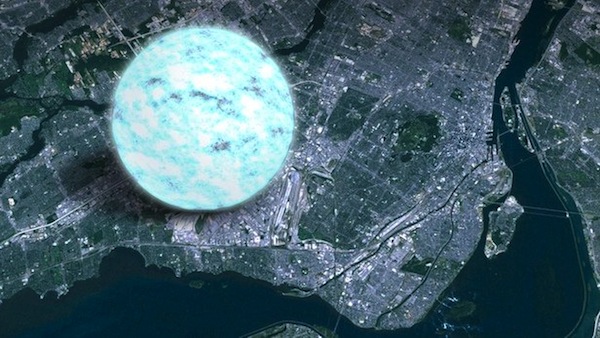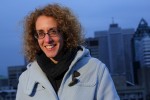Prof. Victoria Kaspi, winner of the 2016 Gerhard Herzberg Canada Gold Medal for Science and Engineering. (photo from McGill University)
McGill University Prof. Victoria Kaspi – the first woman to win the Gerhard Herzberg Canada Gold Medal for Science and Engineering – says that her Jewish background and her parents’ support have had a lot to do with how much she has accomplished.
“Questioning is so inherently Jewish,” she told the Independent. “I think this builds personality, skill, and derived pleasure from talking and thinking. Jews are very studious, loving the books. For some people, it’s the Torah; for others, it’s different types of books … just really enjoying the process of studying, thinking and analyzing. I think that’s what my Jewish background has brought to my work.”
Neither of her parents were scientists. “I just really like it,” she said. “I grew up loving math. My parents were pretty hands off and they certainly never discouraged me. I was sort of an oblivious kind of kid, so if there were cultural signals that I shouldn’t go into science, I must have missed them.
“I think my parents built up my confidence. They never questioned my decisions. When I said I want to go into science, they never asked why I’d want to do that. They used to buy me lots of math toys and puzzles as a kid. Probably my mom encouraged me. She used to play lots of games with me.
“I’m sure I had encouragement from teachers along the way and family as well,” she added. Describing science as “always a great love,” she said it was neither forced on her or strongly encouraged as a study or career path. But Kaspi is aware of the societal pressures on women to not go into science, especially now, with her own daughters.
“They are sometimes subtle and pointing them out can be petty, but when you notice them as an overall trend – where there’s lots of little, tiny subtle signals that, in the end, register very large – I think that needs some work,” said Kaspi of the pressures. “Why I didn’t suffer from that? I’m not sure. I’m hoping that this will improve with time.”
Kaspi uses radio and X-ray telescopes to examine the behavior of neutron stars, using the cosmos as a lab to study the nature of matter in extreme environments.
“The sort of work I’ve done has involved different types of neutron stars,” said Kaspi. “One, in particular, that I’ve done is magnetars, which are neutron stars with very high magnetic fields. They sometimes explode randomly and are just really interesting to study. But there are other things, too.”

Neutron stars are stars that have collapsed and are very dense. A black hole is a star that has collapsed onto itself, due to gravity being so strong that nothing can escape from the surface, not even light; hence, the name, black hole. Neutrons are close cousins of black holes, but some light does escape from them.
“The typical neutron star has as much matter in it as half a million planet earths, but is crushed down to the size of a city,” said Kaspi. “We think a typical diameter of a neutron star is something like 20 kilometres.
“If you’ve crushed all that matter into the size of a small city, you have matter that is extremely dense. If you went up to a neutron star with a teaspoon and you took a teaspoon of the matter, it would weigh something like a billion tons.”
Kaspi said, “We don’t understand the physics of it very well, and that’s one of the things we are hoping to learn by studying them. When studying these objects, we use very powerful computers and algorithms, digital signal processing, there’s a lot of hard work and managing of big data.
“People who study pulsars are snapped up by software companies, because they are really good at developing algorithms, thinking out of the box and finding creative solutions to big data problems.”
Pulsars are rapidly spinning neutron stars and emit a bright beam of light. They are observed through their flashes. If you wanted to go flying around the galaxy and needed a useful, simple way to know where you are, you could use a pulsar. “They all pulse very regularly,” said Kaspi. “You can use that to know where you are in the galaxy and which direction you want to go.”
Kaspi’s research group has used neutron stars to confirm Albert Einstein’s theory of general relativity.
“As scientists, we don’t believe just because a theory is beautiful, it has to be right,” she said. “You have to test it with experiments. These neutron stars allow you to do phenomenal tests of general relativity. Was Einstein right or not? There are other theories of gravity and we can test those, too.”
One of the biggest projects Kaspi is currently working on in Canada is the building of the Chime Telescope in Penticton. She is also looking into “fast radio bursts.”
Of this phenomenon, Kaspi said, “It’s something that’s a big mystery right now that we don’t understand. Astronomers are pretty puzzled over these things. They are very short, a few milliseconds, bursts of radio waves, little blips in the sky that go off randomly but frequently. We think a few thousand go off across the whole sky every day. The first one was discovered a decade ago. Until now, only about 20 have been recorded.”
Kaspi has earned international recognition and numerous awards for her work over the years. As for receiving the Herzberg medal, she said she feels honored, and added, “I may be the first [woman] for this prize, but I won’t be the last. There will be many more women in the future.”
Rebeca Kuropatwa is a Winnipeg freelance writer.

